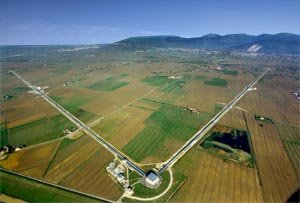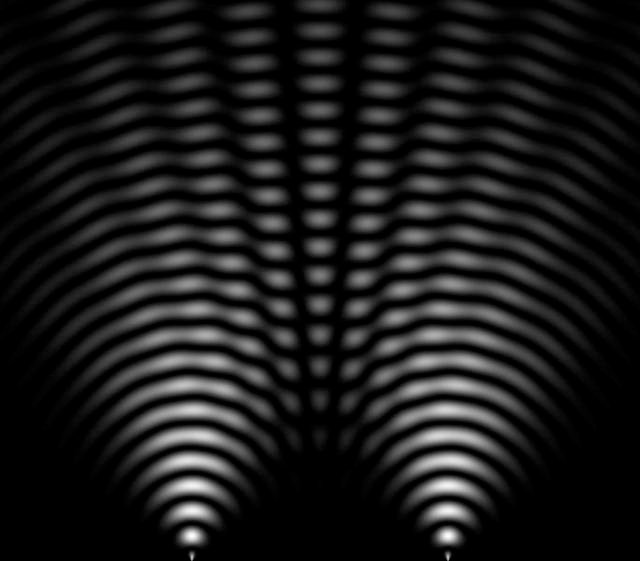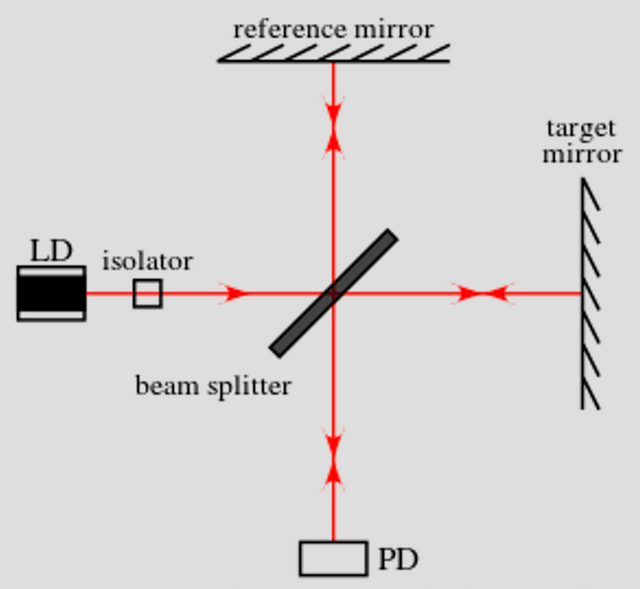Hunting gravitational waves with Virgo and LIGO
In a few weeks from now, SteemSTEM and Utopian.io will meet close to Pisa, in Italy, to visit Virgo labs, one of the few places in the world tracking (and observing) gravitational waves.

[image credits: Virgo]
In a previous post, I detailed the basics underlying this 100-year-old concept of gravitational waves.
As you probably all know it by now, this prediction of the general relativity theory designed by Einstein 100 years ago has finally been observed in a experiment. This yielded the 2017 Nobel prize in physics.
I will not repeat anything with this respect here (please have a look to my old post if needed), except that the challenges were to detect a signal of 10-19m.
Yes, something as tiny as 0.0000000000000000001 meter, which demands a damned precise ruler. And this would be the wave connected to the merging of two black holes, the potentially most cataclysmic event that could happen in the universe. Anything less energetic would also generate gravitational waves, but much weaker.
However, we actually achieved this goal in using interferometry as a ruler. This is what I will talk about with this post. I will detail how LIGO and Virgo work in practice. How these two experiments managed to observe this tiny signal.
WAVES AND INTERFERENCES
In physics, wave interferences consist in the phenomenon yielded by the superposition of several waves (as can be guessed from the name). Without entering deeply into details, the main features are illustrated on the picture below.

[image credits: Fffred (public domain)]
There are two sources of light (at the bottom of the figure) that emit light waves. We can observe, at a given time, an arrangement of bright and darker zones.
At a bright point, the light intensity is larger than the sum of the intensity of the sources. We are calling that constructive interferences. The two waves interfere in a way in which the resulting intensity is larger than the sum of the initial intensities.
At a dark point, we have destructive interferences. It is the opposite. The resulting intensity is smaller than the sum of the initial intensities, and even potentially vanishing.
The Virgo or LIGO experiments rely on two laser beams that interfere with each other, and whose interferences are recorded by the detectors. When a gravitational wave passes around, it induces a perturbation that modifies the way the lasers interfere. And this even with the tiny intensity above-mentioned!
This interference pattern modification is then recorded, and studied, which has allowed physicists to conclude to the observation of the waves.
VIRGO/LIGO AT WORK
To make it a-few-words-short, LIGO and Virgo are ‘simply’ advanced versions of the Michelson interferometer. These detectors hence rely on a single laser beam to create an interference pattern.
As I said above, two waves are needed to get interferences. But this is not a problem. The single laser beam (LD on the figure below) is sent straight to a splitter that splits it in two. Yes, I know, a splitter splits… nothing fancy here…
One of the two resulting beams then aims to the ‘reference mirror’ and the other one to the ‘target mirror’ of the figure, the two beams hence traveling in perpendicular directions.

[image credits: Krishnavedala (CC BY-SA 4.0)]
The mirrors permit to reflect the two beams and send them back to the splitter, that this time acts as a merger.
In other words, it allows to create a superposition of the two light waves, so that they interfere with each other.
The splitter/merger then deviates the merged beam and send it straight to a photodetector (PD on the picture) that records the interference pattern.
In the case where a gravitational wave would go through the entire apparatus, the optical paths of the two laser beams change, and so does the interference pattern. This change is clearly recorded by the photodetector, which then allows physicists to study what happened in detail.
The signal is however tiny (the intensity of any gravitational wave is tiny), and one must make sure to be able to distinguish it from the background.
For this reason, several detectors of huge dimensions are needed. For instance, the two LIGO devices consist of pairs of arms of four-kilometers long in which the beams circulate, whilst Virgo includes two arms of three kilometers each.
The background noise was deeply studied, so that all changes in the interference pattern that it would induce could be tagged as background. Moreover, signal patterns are also known, from appropriate catalogues where the corresponding calculations were done. In this way, a signal can be unambiguously tagged as such.
In addition, gravitational waves travel at the speed of light. This is used to even better unravel the signal in making use of several detectors well separated in space (by several thousands of kilometers). These detectors should detect a signal pattern almost simultaneously, which is used as well for tagging a signal as such: a background event would not be recorded simultaneously at two places located at several thousands of kilometers from each other.
TAKE-HOME MESSAGE
SteemSTEM and Utopian.io are about to visit Virgo Labs and see how gravitational waves are detected (and how one gets a Nobel prize for this). In a previous post, I briefly documented what general relativity was and how gravitational waves could be produced.
In this post, I moved to the second and last opus of this documentation and introduced the concept of wave interferences, and how two interfering waves would generate a pattern of bright and dark zones. Recording such a pattern, and the modifications that would be induced by a gravitational wave going through Earth, is the key that yielded one of the most exciting physics discoveries of the last few years.
I have consequently presented details on how this was precisely done by Virgo and LIGO, the two experiments in which gravitational waves are currently tracked. I hope this will provide some of the necessary bases to understand what we will see at the meetup :)
Please help us in funding our meetup, by for instance supporting our fundition campaign.
STEEMSTEM
SteemSTEM is a community-driven project that now runs on Steem for almost 2 years. We seek to build a community of science lovers and to make Steem a better place for Science Technology Engineering and Mathematics (STEM). In particular, we are now actively working in developing a science communication platform on Steem.
More information can be found on the @steemstem blog, on our discord server and in our last projet reports here and there.
It's interesting to see how they create an interference using a very fundamental behaviour of light - reflection. I'm always in awe when the simplest engineering yields an amazing result. Light behaviour was my favorite topic in physics in the high school.
The engineering is in fact a bit more involved. As the laser has to travel across kilometers, there is actually a very complex system of mirrors allowing to boost its power all along the way. But the key principle if very simple. We know the interference pattern of a gravitational wave and we "just" look for it.
You nailed it, simple principles are the bedrock of most complex systems.
That is so true and holds for so many things... ;)
Thanks Bro'. Upvoted, Resteemed & Followed You.
Super interesting post
Aren't scalar/gravitational waves a faster than the speed of light technology? Like a Thomas Bearden zero-point energy applications? If I understand correctly scalar waves are used for deep space communications to basically send and receive signals to distant space probes instantly?
Thanks for sharing
What is the "speed of light technology"? I am not too sure to get what you are referring to. I won't answer most of your comment because I am not sur to get the question, but feel free to come back to me and we will continue chatting ^^
Just one thing: the golden rule is that nothing can go faster than light. We were assuming that gravitational waves were traveling at the speed of light, but this has only been confirmed a year ago when gravitational waves emitted by the merging of two neutron stars have been observed together with gamma rays originating from the same event (in short, both the gravitational waves and the light arrived to Earth at the same moment).
I never knew black holes can actually merge. Is this phenomenon related to the "Binary Black Hole"?
A binary exactly means a pair of black hole. They rotate around each other, and then accelerate because of their respective gravitational field. As a result, gravitational waves are emitted.
Nice post i think discovery of grovational waves is best discovery in this centery
As the century is only starting, this is not clear. There were however many other striuking discoveries already in many different scientific fields as well. At the endW of the day, I would simply not rank them as I don't think there is really a need for that. This was my 2 cents :D
Hello
Greetings. Many thanks for making this post which, according to you, will provide the necessary background to what attendees will see in Italy during the course of the much publicised meet up. I ain't good with physics or understanding its concepts but the simplicity of this article make it quite comprehensible.
Best of luck with the meet up, and I pray you receive the much needed feedback in terms of sponsoring it.
Respect
@sciencetech
STEM contributor
I hope this will provide enough information to the participants. I guess we will only know if they raise their voice :D
I am happy to read that the article was simple enough. With physics, it is easy to become non-comprehensive in no time ^^
I hope you will join us for our next meetup!
I agree that this was very comprehensible for high level physics. I’m still not 100 percent clear on how the interference is detected, but I think that’s beyond the scope of this post.
I may try to answer... ;)
To make it simple without entering into all glory details.
When something that does not correspond to any known background is seen, one checks whether it is also detected in the other detectors. If yes, we have a wave.
I think I get the points about the destructive and constructive wave interference. Really this meetup will have educative impact on those who are going to observe all that's described here in real life. Certainly gonna be a historic experience for them. Thanks for the efforts. Resteemed
@eurogee
Really happy to be able to provide information about physics to everybody at the same time. That also gives me topic to speak about in my posts (note that I have a to-write list of more than 80 entries, so that it is not like I don't know what to write about :p ).
Thanks for the resteem and your nice wishes for the meetup!
Welcome
The part about constructive and descriptive interference gave me some nostalgic feelings. I wish the participants a good time visiting the virgo lab.
Is my post making you remember some good old physics courses? :D
Thanks for your wishes by the way!
Of course! You are welcome
Congratulations @lemouth! You have completed the following achievement on Steemit and have been rewarded with new badge(s) :
Click on the badge to view your Board of Honor.
If you no longer want to receive notifications, reply to this comment with the word
STOPDo not miss the last post from @steemitboard:
SteemFest³ - SteemitBoard support the Travel Reimbursement Fund.
Hi @lemouth!
Your post was upvoted by @steem-ua, new Steem dApp, using UserAuthority for algorithmic post curation! Your UA account score is currently 6.059 which ranks you at #264 across all Steem accounts.
Your rank has not changed in the last three days.
In our last Algorithmic Curation Round, consisting of 161 contributions, your post is ranked at #8.
Evaluation of your UA score:
Feel free to join our @steem-ua Discord server
Great post about physics
Thanks for passing by and reading it! :)